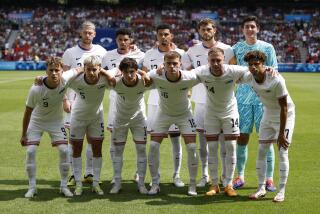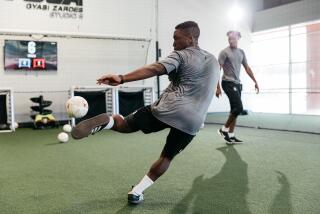Taking a Byte Out of Soccer
SEOUL â When Afshin Ghotbi arrived in the United States a quarter-century ago, he had with him something that has carried him all the way to the semifinals of the World Cup.
Itâs called a love of the game, a passion for soccer that he acquired on the streets and playgrounds of his native Tehran.
Ghotbi was 13 when his family moved to California, and in all the years since, he has tried to instill that same love of soccer in youngsters in the U.S., first by playing alongside them and later by coaching them.
Ghotbi discovered and developed U.S. World Cup midfielder John OâBrien, now starting for Dutch powerhouse Ajax Amsterdam. Ghotbi discovered and developed U.S. Olympic team midfielder Peter Vagenas, now playing for the Galaxy.
Both came to the fore at the American Global Soccer School that Ghotbi founded in 1988 and is now run for him by former Galaxy defender Dan Calichman.
There have been other success stories, many of them, but none that strains the imagination as much as the story Ghotbi is helping to write here.
At 38, he has stumbled upon something that could revolutionize soccer worldwide. Itâs all stored in the laptop computer that almost never leaves his side.
That computer, along with the software within, has plucked Ghotbi out of his home in Rancho Santa Margarita and deposited him on the bench of one of the most successful teams in Korea/Japan â02.
Instead of watching the World Cup on television, the former Glendale High and UCLA player is right here in the thick of it, helping Coach Guus Hiddink make the decisions that have carried South Korea to the final four.
Ghotbi is one of 10 members of South Koreaâs technical staff, an assistant coach in fact if not in name. He is the teamâs âmatch analyst,â a position new to soccer but likely to become increasingly prevalent.
While Ahn Jung-Hwan has been scoring goals, while Hong Myung-Bo has been making tackles and while Lee Woon-Jae has been producing saves--in short, while South Korea has been disposing of such European âpowersâ as Poland and Portugal, Italy and Spain--Ghotbi has kept his hard drive humming and clicking quietly in the background, providing the technological underpinning to Hiddinkâs Korean miracle.
Three things put Ghotbi in this position: a thorough knowledge of soccer, an engineering degree from UCLA and the expertise to understand and use a complicated but intriguing computer program.
He is on the cutting edge of the sport, right at its forward outpost, technologically speaking.
In Japan, a company is developing two-legged humanoid robots that will have the ability to play soccer. In a sense, what Ghotbi has inside his computer is an early version of a soccer brain for such robots. But it is being used to help real flesh-and-blood players, not science-fiction creations.
On a rainy Monday afternoon in Seoul, Ghotbi took time out to give a reporter a little insight into what he does.
He flipped open a laptop and began hitting keys. In rapid succession, graphics appeared, then videos. Before long, it was apparent that what Ghotbi had in hand was every byte of information on every World Cup team and player.
Not only in the form of charts and graphs but in full-color, full-screen video, capable of being manipulated in a dozen ways at the touch of a button and then projected onto a large screen for players and coaches to study.
Want to know what German striker Miroslav Klose will do on a corner kick from the right? Click here. Want to see how the Italian defense reacts when attacked up the middle? Click here. Want to learn how U.S. midfielder Claudio Reyna positions himself when taking a free kick from the left flank? Click here.
Itâs all there, an invaluable database that Ghotbi has compiled during the year and a half he has been working for Hiddink and South Korea.
His enthusiasm for his job and the software program, developed in Australia, is plain to see. So is the influence Hiddink and his Dutch assistants have had on Ghotbi. He speaks of football but he means soccer.
âWhat it does is allow you to digitize or bring in video images--from satellite, VHS tape, or a digital camera that you can use yourself,â he said of the program. âYou put [the images] in the hard drive in your computer and, as they are coming in, you code them.
âSo you actually are like a football librarian, placing images in categories that you think are interesting or important to you.... Then later, when the coach wants to see any book, any chapter, any page, any sentence, any word, itâs there.
âYou can take the image and play it in slow motion, play it backwards, freeze it, and you can draw on it, print it, everything. Itâs brilliant.â
Steve Sampson, former U.S. national team coach, sent Ghotbi down this technology trail four years ago, just before the France â98 World Cup, with a software program recommended to Sampson by Norwayâs coach, Egil Olsen.
âIt was so late in the World Cup preparation that we didnât really get to use it the way we wanted to use it,â Ghotbi said. âBut we used it and we tried to motivate the players, show them tactical moments, and so on.â
Fascinated by the potential, Ghotbi, who played for UCLA as a walk-on under then-Bruin and now Galaxy Coach Sigi Schmid between 1981 and â85, began exploring other software programs, finally happening upon the Australian one and adding to it by creating his own graphics.
He became an expert and soon found himself traveling to Europe and Asia to show club coaches the potential. On one such trip to Japan he met Pim Verbeek, a Dutchman coaching a J-League second division team.
When Verbeek became Hiddinkâs chief assistant with the South Korean national team early last year, he recommended Ghotbi to Hiddink. Ghotbi has been on the payroll ever since.
âItâs unbelievably tedious work,â he said of inputting and sorting all the data necessary, âbut we literally knew everything about every team we played.â
South Koreaâs success at the World Cup is unprecedented. It became the first Asian country to reach the semifinals and seemed to have the measure of more experienced and higher-rated opponents.
In part, that was because Ghotbiâs data have been shared daily with South Koreaâs players. Instead of watching simple video, they are presented with individual breakdowns on the teams and opponents and situations they will face. They know exactly what to expect.
Their own performances are analyzed too.
âEvery player, in my opinion, wants feedback,â Ghotbi said. âIf youâre a top professional, you want to know after a game, âHow did I do? What did I do well? How didnât I do well? What can I improve on?â And these images allow us to not only say it but show it.â
Ghotbi said the approach will become commonplace.
âIt will be one of the most important parts of the football of the future because organization and detail are what separate good teams from great teams, and Korea is a living example of it,â he said.
âIf you look at the Korean players on paper, theyâre not even close to the Italians or the Spaniards. In salary, in quality, you name it. But the Korean team is very tactically organized and has the fighting spirit of a warrior.
âThe players go into every game knowing everything about their opponents. They know exactly where the possibilities are when we attack, and what we need to do defensively to not allow opponents space to do the things they like to do.â
The 2002 World Cup has been a revelation to Ghotbi.
âI think this experience for me in football has been the greatest of my life,â he said. âIf this team wins the world championship, I think we should all retire. We can never duplicate it. I donât think so.
âI donât see how any other nation would be able to support a team like [the Korean fans] have. I donât see any other players who surpass their qualities, who play better than their best, day in and day out. What they have achieved already is remarkable.
âIâm not Korean and I didnât know too much about Korea before I took this job, but when Iâm in the stadium and I see the 50,000 fans and they play the Korean national anthem, I have goose bumps. Just because I see the faces of the people and [realize] what this team has brought them: pride, confidence, the ability to unite. Iâm proud of it.â
Itâs all a far cry from 1977.
âWhen I came to the States, people couldnât even spell soccer, but it was my life,â Ghotbi said.
âI wish more Americans could experience whatâs going on in the streets and in the stadiums here, because theyâd light up like a Christmas tree when they realize what this game means.â






